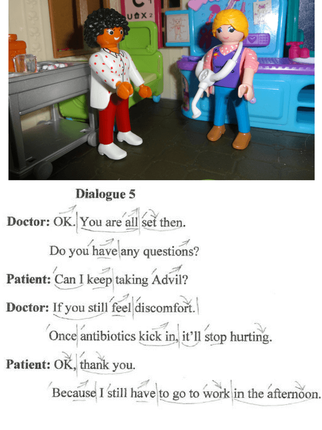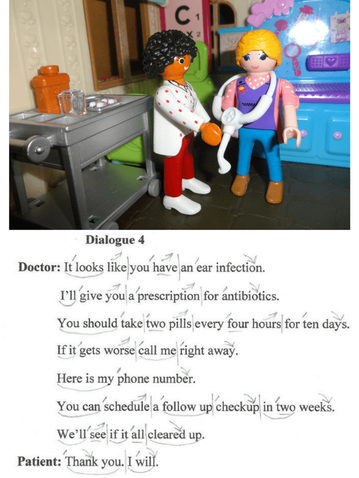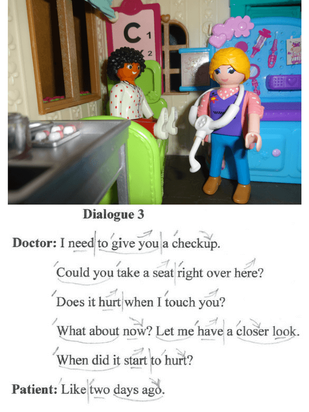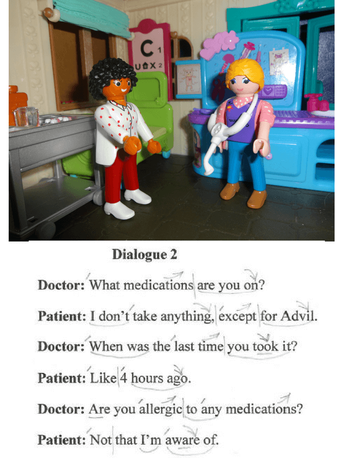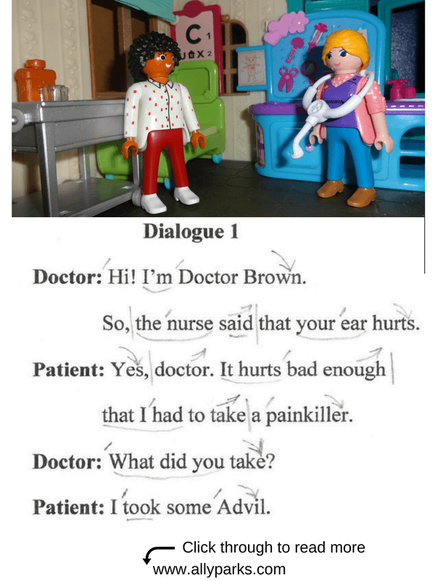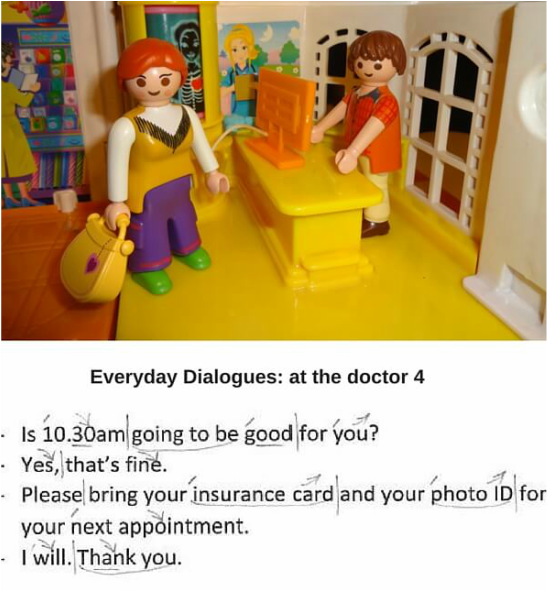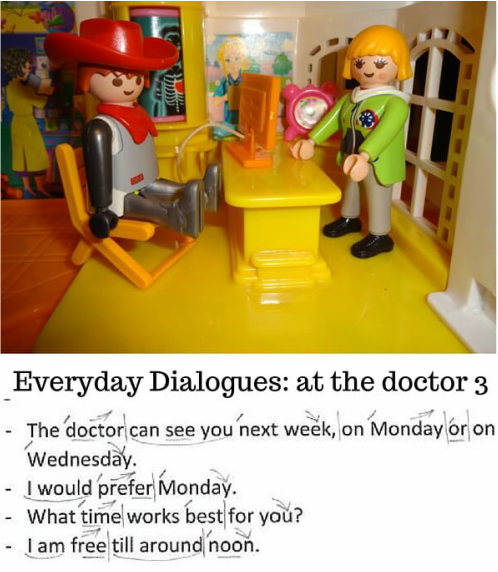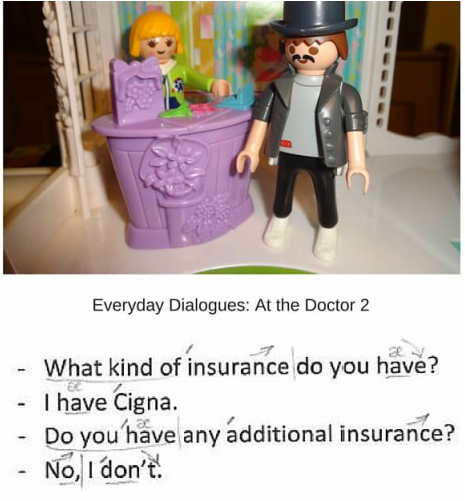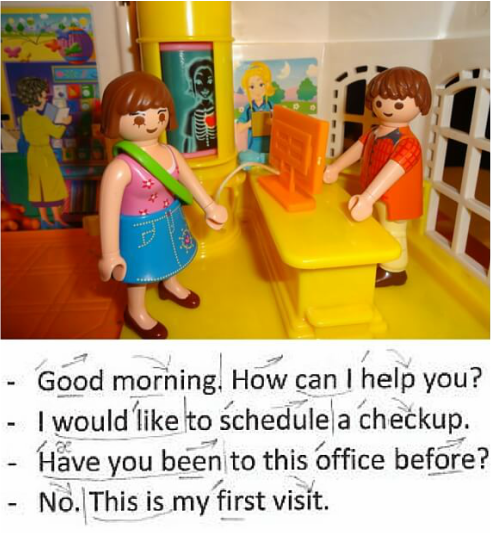|
English intonation and rhythm. I'm sure you've been wondering "Why people don't understand me! I say all the right words, I put them in the right order in the right form." This is all because of the English intonation and rhythm. You have to sound like them. Let me show how they do it. Ready? Here you are. I marked all pauses and the stressed words, showed the intonation going up and down. Let’s look closer. - It looks like you have an ear infection. Pauses are after “like” and “have”. “It looks” are linked. They are pronounced together, with lowered tone and a bit quicker than the rest of the sentence. “looks” is stressed, “like” - intonation goes up. “Have” is stressed, intonation goes up. “Ear” is stressed. “Infection” - intonation goes down. - I’ll give you a prescription for antibiotics. Pauses are after “you” and “prescription”. “I’ll” are linked. “Give” is stressed, “you” - intonation goes up. “Prescription” is stressed, intonation goes up. “Antibiotics” is stressed, intonation goes down. - You should take two pills every four hours for ten days. Pauses are after “take”, “pills”, “hours”. “You should” are linked. “Take” and “two” are stressed. “Pills” – intonation goes up. “Four” is stressed. “Hours” – intonation goes up. “ten” is stressed. “Days” – intonation goes down. - If it gets worse, call me right away. Pauses are after “worse” and “me”. “If it” are linked. “Gets” is stressed. “Worse” – intonation goes up. “Call me” are linked. “Call” is stressed. “Right” is stressed. “Away” - intonation goes down. - Here is my phone number. ”Here is my” are linked. “Phone”” is stressed. “Number” - intonation goes down. - You can schedule a follow up checkup in two weeks. Pauses are after “schedule”, “up” and “checkup”. “You can” are linked. “Schedule”” is stressed, intonation goes up. “A follow up” are linked. “Follow” is stressed. “Checkup” is stressed, intonation goes down. “In two” are linked. “Two” is stressed. “Weeks” - intonation goes down. - We’ll see if it all cleared up. Pauses are after “see” and “all”. “We’ll” are linked. “See” is stressed, intonation goes up. “If it” are linked. “All” is stressed. “Cleared up” are linked. “Cleared” – intonation goes down. - Thank you. I will. Pause is after “you”. “Thank you” are linked. “Thank“ is stressed, intonation goes down. “I will” are linked. “Will” is stressed, intonation goes down. If you are interested in learning more about English intonation and Rhythm, you can download free English Intonation and rhythm checklist. I put the link below the video. Please like, comment and share. Thank you.
English intonation and rhythm. I'm sure you've been wondering "Why people don't understand me! I say all the right words, I put them in the right order in the right form." This is all because of the English intonation and rhythm. You have to sound like them. Let me show how they do it.
Ready? Here you are. I marked all pauses and the stressed words, showed the intonation going up and down. Let’s look closer. - I need to give you a checkup. Pauses are after “need” and “you”. “Give” is stressed, “you” - intonation goes up. “To give you” are linked. They are pronounced together, with lowered tone and a bit quicker than the rest of the sentence. “Checkup” is stressed, intonation goes down. - Could you take a seat right over here? Pause is after “seat”. “Could you” are linked. “Take” is stressed, “seat” - intonation goes up. “Right” is stressed. “Here” - intonation goes up. - Does it hurt when I touch you? Pause is after “hurt”. “Does” is stressed. “Hurt” – intonation goes up. “Touch“ is stressed, “you” – intonation goes up. - What about now? Let me have a closer look. “What “ is stressed. “What about” are linked. “Now” – intonation goes down. Pause is after “have”. “Let me” are linked. “Have” is stressed, intonation goes up. “Closer look” are linked. “Closer” is stressed, intonation goes down. - When did it start to hurt? Pause is after “start”. “When” is stressed. “When did it” are linked. “Start” – intonation goes up. “Hurt” is stressed, intonation goes down. - Like two days ago. Pause is after “Like”. “Like” is stressed. “Two” is stressed. “Days ago” are linked. “Ago” - intonation goes down. If you are interested in learning more about English intonation and Rhythm, you can download free English Intonation and rhythm checklist. I put the link below the video. Please like, comment and share. Thank you.
English intonation and rhythm. I'm sure you've been wondering "Why people don't understand me! I say all the right words, I put them in the right order in the right form." This is all because of the English intonation and rhythm. You have to sound like them. Let me show how they do it.
Ready? Here you are. I marked all pauses and the stressed words, showed the intonation going up and down. Let’s look closer. - What medication are you on? Pause is after “medications”. “What” is stressed, “medications” - intonation goes up. “Are you on” are linked. They are pronounced together, with lowered tone and a bit quicker than the rest of the sentence. “On” - intonation goes down. - I don’t take anything, except for Advil. Pauses are after “anything” and “except”. “I don’t” are linked. “Take” is stressed, “anything” - intonation goes down. “Except” is stressed, intonation goes up. “For Advil” are linked, intonation goes down. - When was the last time you took it? Pause is after “time”. “When was” are linked. “When” and “last” are stressed. “Time” – intonation goes up. “You took it” are linked. “Took” – intonation goes down. - Like 4 hours ago. Pause is after “Like”, “like is stressed. “Four” is stressed. “Hours ago” are linked. “Ago” - intonation goes down. - Are you allergic to any medications? Pause is after “allergic”. “Allergic” is stressed, intonation goes up. “To any” are linked. “Any” is stressed. “medications” – intonation goes up. - Not that I’m aware of. Pause is after “Not”, “not” is stressed. “I’m” and “aware of” are linked. “Aware” is stressed. Intonation goes down. If you are interested in learning more about English intonation and Rhythm, you can download free English Intonation and rhythm checklist. I put the link below the video. Please like, comment and share. Thank you. English intonation and rhythm. I'm sure you've been wondering "Why people don't understand me! I say all the right words, I put them in the right order in the right form." This is all because of the English intonation and rhythm. You have to sound like them. Let me show how they do it. Ready? Here you are. I marked all pauses and the stressed words, showed the intonation going up and down. Let’s look closer. - Hi! I’m Doctor Brown. So, the nurse said that your ear hurts. "Hi" is stressed. “I'm” are linked. They are pronounced together, with lowered tone and a bit quicker than the rest of the sentence. "Doctor" is stressed, "Brown" - intonation goes down. Pauses are after "so" and "said". "The nurse" are linked, "nurse" is stressed, "said" - intonation goes up. "Your ear" are linked, "ear" is stressed, "hurts" - intonation goes down. - Yes, doctor. It hurts bad enough that I had to take a painkiller. Pause is after "Yes", intonation goes down. "Doctor" - intonation goes up. Pause is after "enough". "It hurts" are linked. "Bad" is stressed, "enough" - intonation goes up. "That I had" are linked, "had" is stressed, "take" - intonation goes up. "Painkiller" is stressed, intonation goes down. - What did you take? "What did you" are linked, "what" is stressed, "take" - intonation goes down. - I took some Advil. "Took" is stressed, "Advil" - intonation goes down. If you are interested in learning more about English intonation and Rhythm, you can download free English Intonation and rhythm checklist. I put the link below the video. Please like, comment and share. Thank you. English intonation and rhythm. I'm sure you've been wondering "Why people don't understand me! I say all the right words, I put them in the right order in the right form." This is all because of the English intonation and rhythm. You have to sound like them. Let me show how they do it. Ready? Here you are. I marked all pauses and the stressed words, showed the intonation going up and down. Let’s look closer. - Is 10.30 going to be good for you? We put pauses after “30” and “good”. “10” is stressed, “30” – intonation goes down. “Going to be” are linked. They are pronounced together, with lowered tone and a bit quicker than the rest of the sentence. “Good” is stressed, intonation goes up. “You” is stressed, intonation goes up. - Yes, that’s fine. “Yes” is stressed, intonation goes down. “Fine” is stressed, intonation goes down. - Please bring your insurance card and your photo ID for your next appointment. Pause is after “please”, ‘card”, and “ID”. “Insurance” is stressed, “card” - intonation goes up. “Photo” is stressed, “ID” – intonation goes up. “Next” is stressed, “appointment” – intonation goes down. - I will. Thank you. Pause is after “will”. “Will” is stressed, intonation goes down. “Thank” is stressed, intonation goes down. If you are interested in learning more about English intonation and Rhythm, you can download free English Intonation and rhythm checklist. English intonation and rhythm. I'm sure you've been wondering "Why people don't understand me! I say all the right words, I put them in the right order in the right form." This is all because of the English intonation and rhythm. You have to sound like them. Let me show how they do it. Ready? Here you are. I marked all pauses and the stressed words, showed the intonation going up and down. Let’s look closer. - The doctor can see you next week, on Monday or on Wednesday. We put pauses after “doctor”, “week”, “Monday”, and “or”. “Can see you” are linked. They are pronounced together, with lowered tone and a bit quicker than the rest of the sentence. “Doctor” is stressed, intonation goes up. “Next” is stressed, “week” - intonation goes down. “Monday” is stressed, intonation goes up. “Or” has a long vowel. “Wednesday” is stressed, intonation goes down. - I would prefer Monday. “I would” are linked. They are pronounced together, with lowered tone and a bit quicker than the rest of the sentence. “Prefer” is stressed, intonation goes up. “Monday” is stressed, intonation goes down. - What time works best for you? Pause is after “time and “best”. “Time” is stressed, intonation goes up. “Best” is stressed, “you” – intonation goes down. - I am free till around noon. Pause is after “free” and “around”. “I am” are linked, They are pronounced together, with lowered tone and a bit quicker than the rest of the sentence. “Free” – intonation goes up. “Till around” are linked. “Noon” is stressed. Intonation goes down. If you are interested in learning more about English intonation and Rhythm, you can download free English Intonation and rhythm checklist. I put the link below the video. Please like, comment and share. Thank you.
English intonation and rhythm. I'm sure you've been wondering "Why people don't understand me! I say all the right words, I put them in the right order in the right form." This is all because of the English intonation and rhythm. You have to sound like them. Let me show how they do it.
Ready? Here you are. I marked all pauses and the stressed words, showed the intonation going up and down. Let’s look closer. - What kind of insurance do you have? Pause is after “insurance”. “What kind of” are linked. They are pronounced together, with lowered tone and a bit quicker than the rest of the sentence. “Insurance” is stressed, intonation goes up. “Have” is stressed, intonation goes down. - I have Cigna. “Cigna” is stressed. Intonation goes down. - Do you have any additional insurance? Pause is after “have”. “Do you have” are linked. They are pronounced together, with lowered tone and a bit quicker than the rest of the sentence. “Have” and “additional” are stressed. “Insurance” – intonation goes up. - No, I don’t. Pause is after “No”, intonation goes up. “Don’t” is stressed. Intonation goes down. If you are interested in learning more about English intonation and Rhythm, you can download free English Intonation and rhythm checklist. I put the link below the video. Please like, comment and share. Thank you. English intonation and rhythm. I'm sure you've been wondering "Why people don't understand me! I say all the right words, I put them in the right order in the right form." This is all because of the English intonation and rhythm. You have to sound like them. (And I created a Checklist just for you) Are you ready? Let’s go. I marked all pauses and the stressed words, showed the intonation going up and down. Let’s look closer. - Good morning. How can I help you? Pause is after “morning”. “Good” is stressed, intonation goes up. “Morning” has long O, intonation goes down. “How” – intonation goes up. “Can I” are linked, we say them together, with lowered tone and a bit quicker than the rest of the sentence. “Help” is stressed, intonation goes down. - I would like to schedule a checkup. Pauses are after “like” and “schedule”. “Would like” are linked, we say them together, with lowered tone and a bit quicker than the rest of the sentence. “Like” is stressed, “schedule” is stressed, intonation goes up. “Checkup” is stressed, intonation goes down. - Have you been to this office before? Pause is after “been”. “Have you been" are linked, we say them together, with lowered tone and a bit quicker than the rest of the sentence. “Have” is stressed. “Been” – intonation goes up. ”Office is stressed. “Before” – intonation goes up. - No. This is my first visit. Pause is after “no”. “This is” are linked, we say them together, with lowered tone and a bit quicker than the rest of the sentence. “First” is stressed, “visit” – intonation goes down. If you are interested in learning more about English intonation and Rhythm, you can download free English Intonation and rhythm checklist. I put the link below the video. Please like, comment and share. Thank you. |
